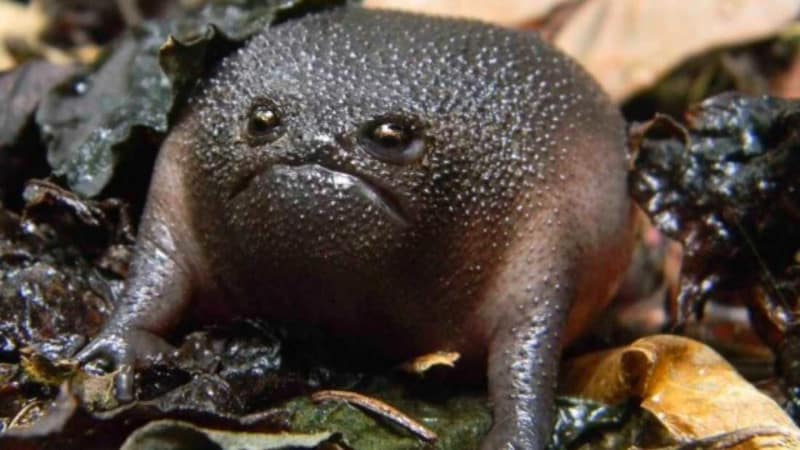Black Rain Frog Facts
- The highly distinctive term of Black Rain Frog presently serves as one of the common names for a remarkable variety of amphibian. However, the intriguing creature also goes by several other common names. Each of these, in turn, remain comparatively descriptive, though.
- These alternate names for the amphibian include such equally distinctive terms as the plain rain frog, brown short-headed frog, and the Tsitsikama frog. The scientific moniker for the amazing animal, meanwhile, is that of the rather difficult to pronounce title Breviceps fuscus.
- The intriguing creation of Nature and evolution received that specific designation due to the efforts of John Hewitt. The respected South African zoologist accomplished the first recognition of it as a separate and distinct species. He achieved that noteworthy feat in 1925.
- This fascinating species additionally remains extremely well known for its possession of several unique physical characteristics. Its ability to puff its body up to several times its normal size easily ranks high among these. It can also, however, fold its legs up under its body at will.
- Most fortunately, the IUCN currently lists the marvelous Black Rain Frog as a Species of Least Concern. This less than common status appears on the organization’s published Red List of Threatened Species. The group routinely updates that, to reflect changing situations.
- The amazing animal nonetheless still faces various threats to its continued existence as a species, however. One of these dangers consists of its highly limited habitat range. Its greatest threat, though, most likely comes in the form of the effects of ongoing climate change.
Related Articles
Black Rain Frog Physical Description
The breathtaking Black Rain Frog rarely fails to capture the immediate attention and interest of those individuals fortunate enough to encounter one. Unlike many of its countless relations around the world, however, it doesn’t do so due to its size. In that regard, it ranks as comparatively small.
It also follows a pattern of development common among fauna, including those kindred. That’s the fact that it displays a certain degree of the physiological characteristic of sexual dimorphism.
In its particular case, this trait manifests in several manners. Females attain a larger overall size than their male counterparts. They average roughly 2 in (5 cm) in body length, while the males only reach a mean of about 1.7 – 1.8 in (4.2 – 4.5 cm). Females also tend to be bulkier and rounder in their form.
The awesome creature also presents another gender-based difference for the observer. Males possess a subgular vocal sac used for calling during the breeding season. These same individuals also evolved the presence of nuptial pads, which aid in gripping the female during mating activities.
For most, the color pattern of the Black Rain Frog remains the most unique aspect of its physiology, though. The amphibian typically presents an overall dark brown coloring, so much so that it often appears black. Uniquely, its skin lacks the warts common among frogs, but show small tubercules.
The very shape of the body itself also catches the attention of most of those who meet them. It develops as comparatively squat and compact in terms of overall form. The legs generally remain short, relative to others of its kind. These all combine to provide it with a distinctive appearance.
- Kingdom: Animalia
- Phylum: Chordata
- Class: Amphibia
- Order: Anura
- Family: Brevicipitidae
- Genus: Breviceps
- Species: B. fuscus
Black Rain Frog Distribution, Habitat, and Ecology
The fascinating Black Rain Frog evolved as native to only a highly limited portion of the surface of the earth. Just how small that zone of habitation qualifies as, and where its location lies, might surprise some people. That’s true since the amphibian wonder only lives in a tiny section of Africa.
Perhaps most notably, the remarkable product of Nature and evolution appears to only be indigenous to the Cape Fold Mountains, located in southern South Africa. Even within that minimal range, however, the marvelous frog displays very specific preferences for where it makes its home.
This remarkable fauna also displays highly specialized preferences regarding its choice of habitats. It clearly favors Mediterranean-type shrubland vegetation unique to its region. This unique amphibian typically inhabits regions of both forests and heathlands on slopes and mountain plateaus.
Altitude also plays a partial role in its selection of locations in which to reside. It typically appears at heights ranging from approximately sea level up to around ,280 ft (1,000 m). This wondrous creation of evolution additionally requires the presence of soil soft enough for its burrowing.
The mesmerizing Black Rain Frog evolved as principally nocturnal in its habits. It remains mainly active after nighttime rains. Being carnivorous, it’s also during this time that it hunts its prey. This dietary fare consists mostly of insects and other small invertebrates, like ants, termites, and worms.
In turn, it itself faces danger from its own share of predators. These hunters most likely include such highly varied threats as birds, snakes, and small mammals. Its natural and efficient camouflage, burrowing behavior, and ability to significantly inflate its body act as its primary means of defense.
Reproductive activities take place during the local rainy season. Unlike most frogs, it does not require the presence of open water for this. Females lay their eggs in the underground burrows of the males. Incredibly, this species skips the tadpole stage. Eggs hatch directly into small froglets.
Species Sharing Its Range
Check out our other articles on 6 Stunning North American Bees, Punaluʻu Beach, Coral Honeysuckle, Humpback Whale, Bloody Hell Pond, Black-Margin Cyerce, Missouri River, Green Iguana

